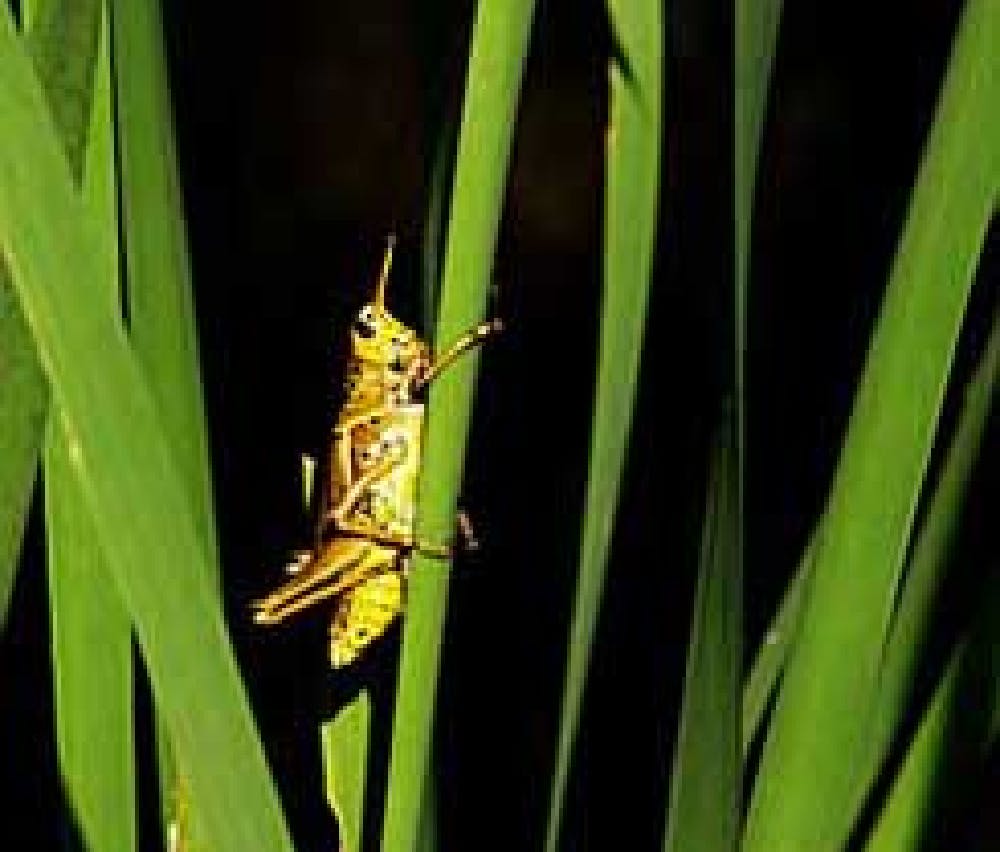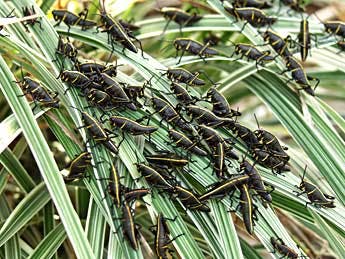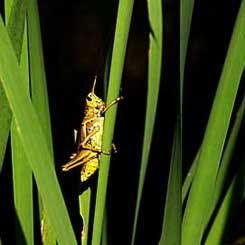
Lubber Grasshoppers


Gallery


Symptoms
If immature or mature lubbers are not observed, their damage to plant leaves and flowers is impossible to miss. These massive grasshoppers are capable to chewing tough cattleya leaves down to the psdeudobulb or, in some cases, pseudobulbs all the way to the rhizome given enough time.
Treatment
Chemical control is effective only against the nymph stage. There are several insecticides toxic to grasshoppers that are registered for use on ornamentals, fruits and vegetables, such as dimethoate, acephate and the family of neonicotinoids. The adult insects are best eradicated by hand.
Because most species are fairly slow moving and all are harmless to humans, they can be handpicked from a favored plant or netted. Various orchid growers recommend their own preferred lubber-control weaponry, including a brick, shoe, broom or even the broad side of a machete, but squashing them does seem to be the favored approach.
Prevention
The only prevention is to destroy the adults before eggs can be laid near their preferred host plants.
Additional Information
By Susan Jones
Different species are found in various geographic regions of the United States: eastern lubbers (Romalea guttata, found from central North Carolina west through southern Tennessee, Georgia, Alabama, Mississippi, Louisiana, Arkansas to Texas and throughout Florida), horse lubbers (Taeniopoda eques, native to Texas and Arizona, down into Mexico), plains lubbers (Brachystola magna, most commonly found on the prairies of the western part of the United States and Mexico) and southeastern lubbers (Romalea microptera, which spread out from North Carolina to Florida, west to Louisiana and northeast to Tennessee).
Description
Although there is some variation among the different species, all are flightless and quite large as grasshoppers go, with females attaining greater length at maturity than males. Distinctively colored and patterned, the immature ones have different coloration from their adult counterparts. All share the chitinous exoskeleton typical of grasshoppers that helps protect them from predators and prevent dehydration.
Eastern lubbers are flightless, although not wingless. They move from place to place primarily by walking, but are capable of jumping short distances. Adults of this species are yellow, spotted black, with red coloration under their wings, and reach 2? (6 cm) to more than 3 inches (8 cm) in length.
Unlike some of their less athletic cousins, horse lubbers have long hind legs that allow them to cover distances of up to 20 times their own length in a single jump. These lubbers are black at maturity, with yellow markings and black-and-orange-striped antennae, and attain a length of 2½ inches (6.4 cm).
Flightless plains lubbers are also capable of jumping from several inches to several feet using their oversized hind legs. Their bodies are reddish brown in color, marked with greenish brown. Their wings are colored with ABOVE Southeastern lubber nymphs feeding on landscape foliage. reddish brown and black spots, and they have a row of light-colored dots on their abdomens. The smallest of the lubbers, this grasshopper is still fairly large, reaching up to 1? inches (4 cm) in length as an adult.
Adult southeastern lubbers come in two color schemes: mustard yellow with black markings, the southerners among them with a reddish stripe as well, or black with yellow stripes. They grow to be 2–2¾ inches (5–7 cm) in length, and are flightless.
Life Cycle
After mating, lubbers deposit caches of approximately 25 to 50 eggs, depending on the species, in the ground during the summer. These eggs overwinter underground and begin to hatch out from mid-March to June, depending on the region. In warmer areas, such as the southeastern United States, the hatching is earlier, while for species such as the plains lubbers in the western parts of the country, later spring is the expected arrival time for the young. The wingless nymphs (immature grasshoppers) crawl up out of the soil in groups and begin their search for food. The young lubbers will molt their exoskeletons five times at roughly 15-day intervals before reaching adulthood, when they settle down to breed and begin the cycle anew.
Habitat and Feeding
Although each type of lubber has its preferred plant or plants on which it feeds in its natural environment, all are fairly catholic eaters and, given the opportunity, will usually cause damage to a wide variety of greenery. This includes one’s prized orchids. Young lubbers usually travel in large numbers, swarming and devouring plant material as they go. Knowing which plants they favor can help growers to be on the lookout for these pests; also, keep orchids far away from host plants. Eastern lubbers are most often found in open pinewoods, weedy fields and the vegetation along roadsides. Their preferred foods include the foliage of citrus, vegetables and ornamental plants. Horse lubbers stick to grasslands and oak woods, desert annuals and foliage of perennial shrubs, including mesquite. The plains lubbers hang out in the prairies, roadside vegetation, in vacant lots or at the edges of fields. Their favorite food is sunflowers, but they will also consume various grasses, weeds and many other types of flowers and young cotton plants. Southeastern lubbers frequent roadsides, field edges and gardens, noshing on ornamentals, vegetables and even citrus leaves.
Defensive Characteristics
Lubbers have at their disposal a variety of relatively unpalatable means of defending themselves against threats from other creatures.
The bright coloration and patterning on a lubber’s shell is an aposematic, or warning, pattern to predators that they are unpalatable to downright poisonous. Lubbers ingest and assimilate substances in the plants they consume that, although harmless to humans and the lubbers themselves, are toxic to many predators. These chemicals may kill smaller creatures such as birds or leave larger animals quite ill after ingesting a lubber.
If their color pattern is insufficient to warn off a would-be predator, the lubbers are capable of secreting a noxious foam while making a loud hissing sound when threatened. In addition, like most grasshoppers, they can also regurgitate a dark brown liquid (commonly called tobacco spit) as a defense.
Controls
Chemical control is effective only against the nymph stage. There are several insecticides toxic to grasshoppers that are registered for use on ornamentals, fruits and vegetables, such as Cygon. These are not, however, approved for use on orchids. If control of the young lubbers on host plants for which the insecticides are approved is the goal, chemical control is an option. Otherwise, these pests are best eradicated by hand.
Because most species are fairly slow moving and all are harmless to humans, they can be handpicked from a favored plant or netted. Various orchid growers recommend their own preferred lubber-control weaponry, including a brick, shoe, broom or even the broad side of a machete, but squashing them does seem to be the favored approach.
References
"Horse Lubber Grasshopper.” Todd’s Desert Hiking Guide. 2001–2003.
Jackson, Dr. Jerome A. “Lumbering Lubbers.” With The Wild Things column, WGCU Public Media.
MacCubbin, Joani “Lubber Grasshoppers.” Joani’s Corner at Betterlawns.com.
May, Peter. “Lubber Grasshoppers.” Biology Department, Stetson University, Deland, Florida.
“Plains Lubber Grasshoppers, Brachystola magna” The Big Zoo. Home:Zoo: Insects: Crickets and Grasshoppers:Lubber Grasshoppers:Plains Lubber Grasshopper, 2004.
Scherer, C. W. “Eastern Lubber Grasshopper, Romalea guttata (Houttyun).” Document EENY-006, Featured Creatures Series, Entomology and Nematology Department, Florida Cooperative Extension Service, Institute of Food and Agricultural Sciences, University of Florida. October, 1996.
“Southeastern Lubber Grasshopper, Romalea microptera” Field Guides, Insects and Spiders: Grasshoppers, Crickets, and Cicadas. National Wildlife Federation.
Susan Jones was the editor of Awards Quarterly and assistant editor of Orchids. American Orchid Society, 16700 AOS Lane, Delray Beach, Florida 33446
All reuse must contain the follwing:
Reprinted from the SEPTEMBER 2003 issue of Orchids -- The Bulletin of the American Orchid Society. Copyright American Orchid Society --www.aos.org

FREE ACCESS: Orchid DealWire
Get notified when orchid vendors have special promotions and exclusive savings.








